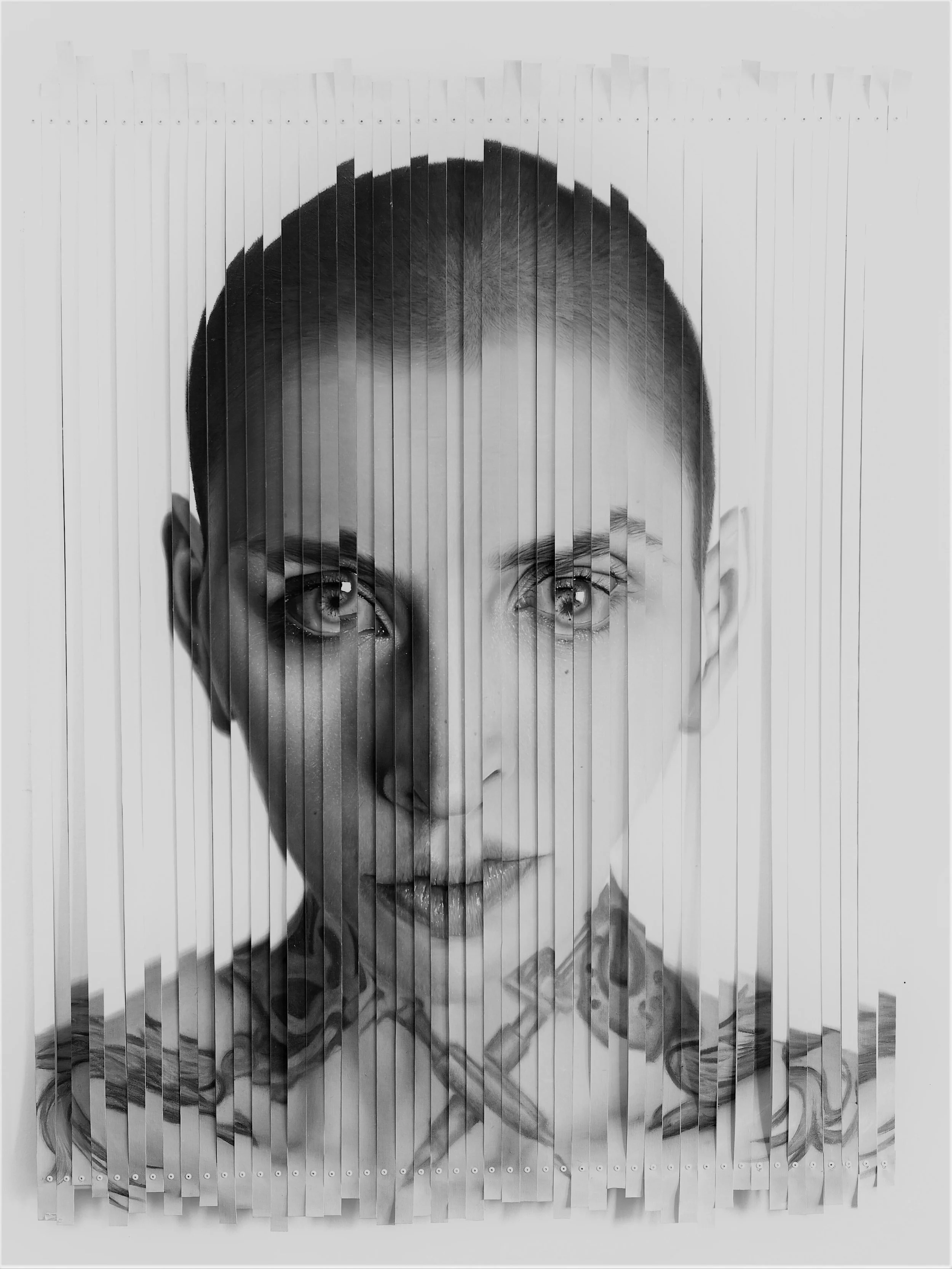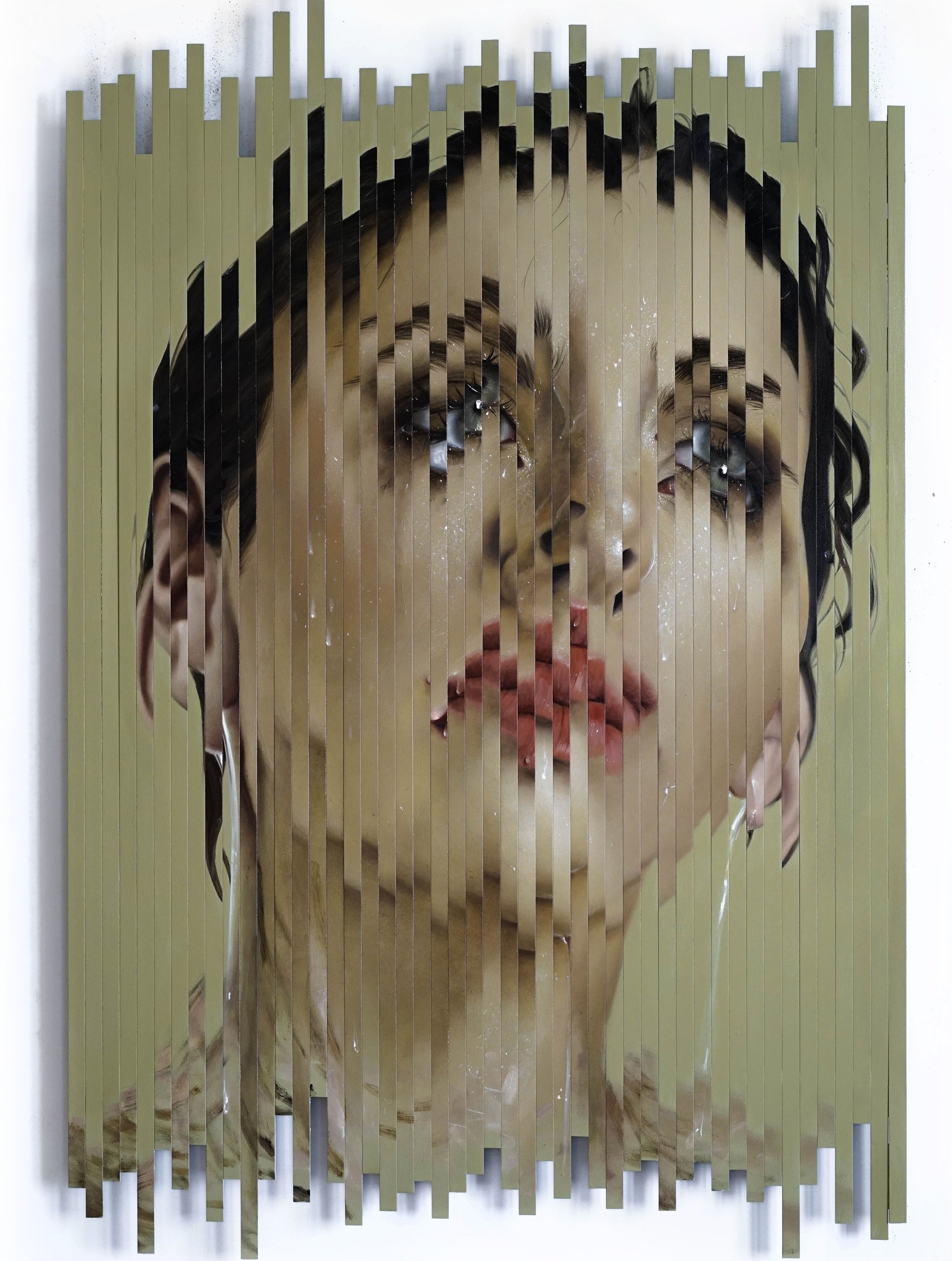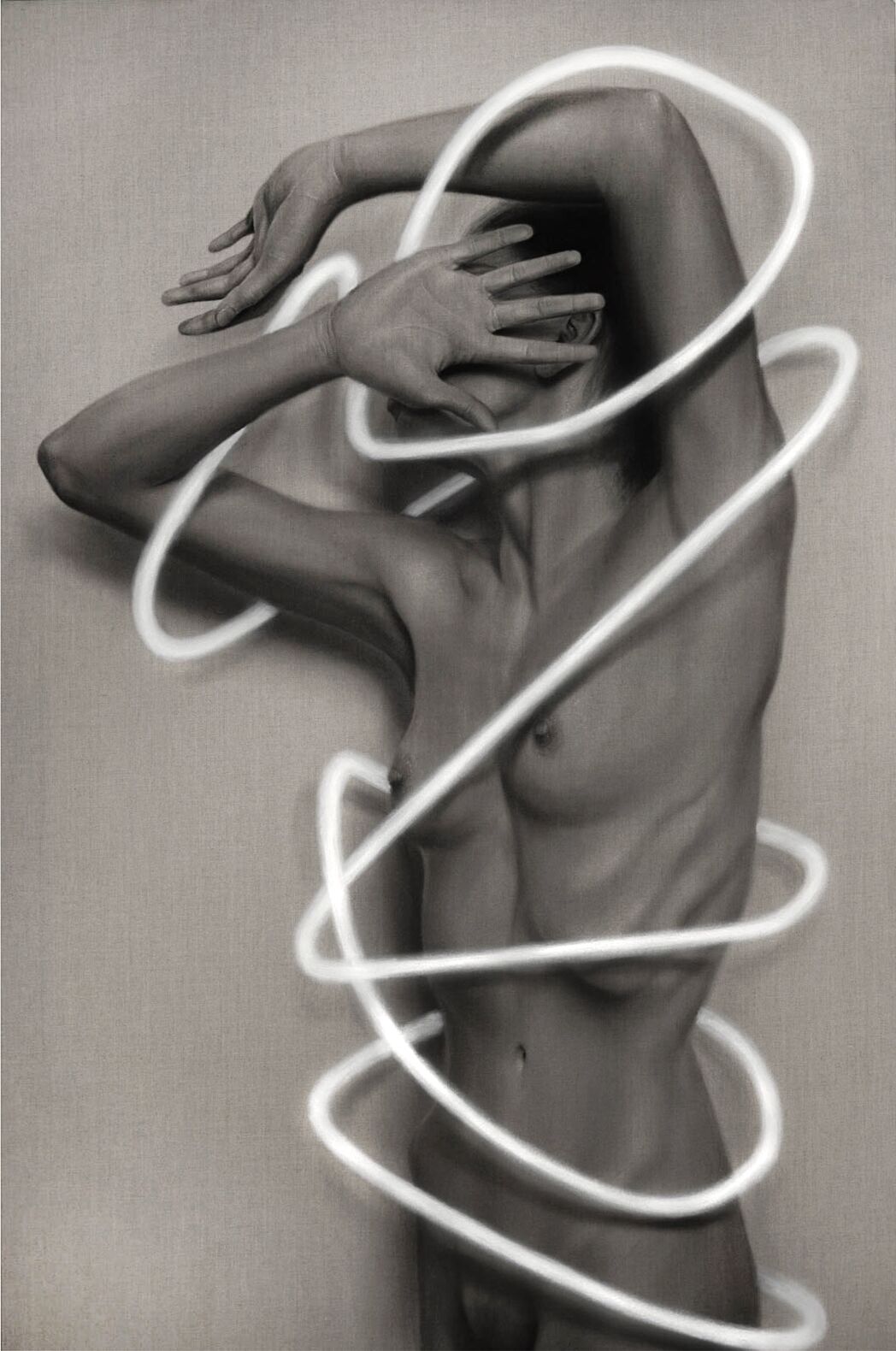Best of 2019 - KIT KING
We are republishing popular and notable interviews from the past year. This interview was originally published in February 2019.
Kit King is a Bahamian Canadian artist who creates large scale hyperrealist works. Her pieces are often shredded and rearranged to influence the ways in which they are perceived. In this interview she discusses her conceptual approaches to art making within our disposable society.
Interview by Tyler Nesler
In the beginning of your journey as a painter, were there any styles you were initially interested in before you arrived at hyperrealism? How has hyperrealism shaped your perception and experience as an artist?
There was no beginning to this journey in the sense of a defined starting point. I’ve been painting from before I could walk or talk. While I was growing up you could see the art follow the lead of realism. My scratchy kid drawings started to become more refined the more I drew or painted. Hyperrealism was just the natural evolution of that refinement. I don’t know that it’s shaped my perception as an artist — I feel I am the artist I am because of the way I see things. I’m someone who notices every detail. I’m someone who is very obsessive and compulsive with control issues. I think this style of art I create is simply an extension of these traits. Less to do with my artist self and more to do with who I am past the artist persona. If I’m having a day where my anxiety is particularly troubling, I tend to become more compulsive in daily tasks — very structured, less forgiving — all in this quest to feel some semblance of control over what’s happening internally, by fixating on controlling the external. So when I paint in these moments you can see my work is more controlled as well. Whereas the days where I’m less troubled by the internal, my work loosens up.
Your work is very photo realistic yet your images are also often distorted by being spliced into strips and rearranged unevenly. This creates an almost pixelated or digitized look, while also adding this unique element of chaotic fluidity. What are your intentions with the splicing? What initially inspired this idea?
That was just one body of work I’ve explored. The concept centers around the disposable nature of society and how this infiltrates our relationships and the lives we cultivate. So imagine a photo of a person, and it has gone through the shredder to be discarded…this is the visual foundation for the sliced works. My intent with that oeuvre was to make people stop and think. There are so many comments of, “Oh my gosh, why would you cut your painting up! Why destroy it?,” I needed to spend countless hours painstakingly rendering a portrait painting only to cut the whole thing up afterwards to elicit this response from the viewer. With the message being: if it upsets you so much to see me destroy this luxury item — an object — why does it not upset you to see a person being destroyed in life? Is a real human soul not worth more than an object based on that reality? As a society we have become accustomed to discarding so much. We don’t try to fix it. We just throw it away. So I started to wonder if this behavior is why we have come to so readily discard our fellow man? Not work on repairing our relationships? How does living in a disposable society affect us as humans and the people we interact with? So the reconfiguring of the portraits was this tangible manifestation of this change — this altered state of when someone has been torn down by man. As well as the image of what it’s like when we try to repair this damage and piece ourselves back together.
The Weight of Knowing
The Killing of Truth
Are there any other ways to aesthetically manipulate an image that have caught your attention? Do you have any ideas percolating about different methods to add a "Kit King twist" to a hyperrealist image?
Yes — the oeuvre before that slicing one utilized a manipulation of dimension. You can see this is my solo show “Dimensional Analogue.” I’ve also had an ongoing “floating paint series” that manipulates paint as a two dimensional object. I have a ton of ideas (more than I could ever realistically complete in a lifetime). But the goal isn’t ever to manipulate reality — more to enhance it — and sometimes that just means adding a twist that hopefully gets the viewer’s mind turning.
Retrogression
Do you have any day-to-day rituals or routines that you've developed as you've continued making art? Does much pre-planning go into a piece, or do you tend to discover its ultimate form as you go along?
I’ve written about this a lot before. Though I’m incredibly anal as an individual and like my routine; ritualistically in the art sense — I’m more free flowing. I think it’s especially important in art to not tighten the reigns too much on process. It can be very limiting. I feel like the more open I am to process, the more room for potential growth.
One of the most incredible things about being an artist is the freedom, so I try not to cage that experience. Some pieces have had deep methodical plans because the pieces required it, and others have been spur of the moment — didn’t even know where I was going with it until it was done. Whatever mood I’m feeling is what carries into my process. This is key to staying out of that artist block rut.
Deconstructed
I've noticed that the faces in several of your portraits seem lit from below, which emphasizes the jawline and adds a distinct shine to the subject's eye. What attracts you to rendering a face in this manner? Are you going for a certain tone or mood that influences the way the viewer perceives the subject?
Absolutely. You never see light in nature come from below — so it can only ever be created by man. This instantly grabs your attention as something being “off,” which suits the narrative of much of the work I produce. I often describe my art as the product of living in what I call “Backwardslandia,” this feeling that so much of how our world is structured is so fucking backwards. Something about this life seems “off” to me. So the lighting reflects this, but also in lighting from underneath it captures vulnerability. When we expose our necks, it has this metaphoric and very real sense of vulnerability. This juxtaposition of abrasive light paired with the softness of a neck and jawline are hypnotic to me. It instantly makes me feel something raw and real despite the manufactured light source.
There is an immediacy of emotion to much of your work. When you dive into the creation of a piece, are you operating from a specific emotional place that you want to imbue the work with? Do you locate the source of the emotion more directly from the subject, or from within, or is it a combination?
So this ties into the previous question, but yes. I create what I do because I’m an incredibly emotional individual. I feel intensely and my art is an extension of my voice for the things I cannot articulate with words — and though many of my works have a narrative, it’s about feeling. What is the emotion behind the narrative? How does this idea make me feel? And this feeling is sort of omnipresent — some days it’s at the forefront of my mind, and other days it’s a humming in the background. But it’s always there and I’ve not been able to pinpoint it — so I’ve been trying to capture it in paint. From what I can discern it comes from a place of isolation — feeling that something is wrong with this world and questioning if I belong here.
How does the impulse to create a work in color differ from what spurs you to create a work in monochrome? What different visceral impacts do you think color possesses versus black and white?
Oh I never want to create in color. I despise it. I find it overstimulating and would never hang them in my home. I even go as far as covering them when I’m not working on them in the studio. But that’s where being a career artist comes in — most people want color. Galleries always ask me for color. People respond better to color, and it’s easier to push a narrative and emotion on someone by color manipulation. I find something so artificial about color in art. Do I feel the way I feel because of the content or the tones used that are manipulating/creating these feelings?
I suppose the answer isn’t as black and white (pun intended) — I’m sure it’s more of a point that the imagery and color work in tandem to elicit a response. But I’m much more interested in getting that feeling across with no color to manipulate the feeling/emotion. (I suppose it can be argued that monochrome is another way to manipulate emotion, but definitely not to the degree color can). I find it much more difficult to get the emotional impact across in colorless work — the piece really has to be strong and able to hold its own so that it works without color to support it. I don’t know, I just have a distaste for color, for how it makes me feel. Probably much to do with the anxiety and the fact I’m very easily overstimulated. You’d be hard pressed to find someone who dislikes color as much as I do. I don’t like art to yell at me. I like it to have a quiet conversation with me.
You have done thematically connected series (such as your body image-oriented works for your solo exhibition "Playgrounds" in 2017). How much is a sense of narrative in your work also a conscious choice for you? Do you ever set out to depict a kind of narrative across pieces, or does it tend to evolve as a springboard from one creation to another?
It happens so fluidly that I’m not sure what comes first. I don’t know how much is choice. I just paint the things my mind yells at me. Purge it from my mind by pouring my soul on canvas into a body of work. If I have qualms with something, I paint through it as a means to navigate the struggle. Though they all separate visually, they all float back around Backwardslandia in some fashion. They are just a collection of the many things I struggle to grasp in this world. Why we are the way we are as a society and grappling with the isolative feelings associated with these thoughts.
Works from the “Playgrounds” solo exhibition
Your work focuses primarily on human faces and the human figure. Is the study of the human form an intrinsic aspect to your art? Do you think you will ever embark on a project that centers on non-human-centered subjects?
That’s just what I’m known for and what I have built my career from. But my work extends far past portraits and figurative work. I’ve explored everything from other realms of realism like landscapes and still lifes, to completely abstract works with no representationalism at all.
If you look hard enough you can find it on the internet in little corners here and there. If you look in my studio it looks like many artists work there. Varying styles and varying techniques. I love exploring — again that freedom that comes with being an artist and not wanting to restrict my journey.
Making art is such a subjective and personal endeavor, and I think it's rare to find another person on a creative wavelength that compliments your own. But you seem to have found exactly this, as you have a very close creative and collaborative partnership with your husband, Oda. Has this relationship evolved to the point where if you are creating a piece on your own, do you think there is an underlying element of his creative perspective or insight informing the work, and vice versa?
So we met because we drew the exact same thing and I thought he was copying me. So right away we were on the same page. It’s what lead us to being married and working together. He doesn’t have that same nattering voice in his mind that I do, so our work is always separate in the emotional aspect you get from each of us. We’ve often had the same idea for a painting, but the essence of the completed works is unique to our minds. Oda is very much about finding the beauty in this world, where I’m very much about using art to navigate the worst parts of this world. When we work together it’s because an idea overlaps but while I’m painting it I feel and bring my essence to it, while he brings his. This mix of pain and beauty, this harmonious balance that really speaks about life in a more rounded sense.
This balance is very much the core of our marriage and artistic partnership. We balance each other in every sense. Though from the outside it can seem as though we’ve seamlessly melded into one, it’s more like two opposing halves that complete a piece — separate in their own right, but you need each piece to build the whole.
What's coming up for you in the near future? Any new shows or works that you would like people to know about?
I always have fun projects on the go. This year I’m very fortunate to be back working on some collaborative pieces with my husband for some upcoming art fairs. We’ve had an idea for some work we’ve been dying to create that is the perfect example of what I just touched on in the previous question, and the perfect opportunity came up for us to do this.
I also have my solo show in Munich (at Benjamin Eck Gallery), starting in September, so most of my year will be dedicated to creating new works for this show.
And any spare moments in between will be spent with Oda slowly building our side project of design-based functional art works that has been our “hobby,” which we hope to one day bring off the sidelines. But being as busy as we are with our painting exhibits, it’s a slow growing project, so the release may not be for a bit yet — but stay tuned!
View more of Kit’s work on her site and on Instagram.
You might also like our interviews with these artists:
Special thanks to William Walker Jr. for assistance with this interview.
Tyler Nesler is a New York City-based freelance writer and the Founder and Managing Editor of INTERLOCUTOR Magazine.












